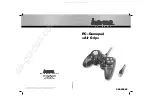
82571EB/82572EI EEPROM Information Guide
1
1.0
Introduction
A series of 82571EB/82572EI EEPROMs are developed and validated as part of the 82571EB/
82572EI validation effort. These dev_starter images represent a cross section of configurations that
are available. Intel strongly recommends that designers use the dev_starter image that corresponds
most closely with the desired configuration options. Dev_starter images have been fully validated
with the reference design and can be used to ensure that the base functionality of a specific design
is working as expected.
Dev_starter images are developed using generic modules (modules that expose a particular feature
in a given EEPROM). Because some features are mutually exclusive, these modules are developed
to preclude any generation of an EEPROM that has conflicting features. If a dev_starter image does
not contain all the appropriate features that a specific design requires, please contact your Intel
representative instead of modifying individual word or bit assignments to avoid conflicts.
The 82571EB/82572EI uses an EEPROM device to store product configuration information. The
EEPROM is divided into three general regions:
•
Hardware Accessed —
Loaded by the Ethernet controller after power-up, PCIe* reset de-
assertion, in-band PCIe* reset, a D3 to D0 transition, a software commanded EEPROM read
(CTRL_EXT.EE_RST), and a software reset (CTRL.RST, word 00000h, bit 26).
•
Software Accessed —
Used by software only. These registers are listed in this document for
convenience and are only for software and are ignored by the Ethernet controller.
•
Firmware Accessed —
Used by BMC, PT, SPT, or ASF firmware (For more information
about manageability, contact your Intel field representative).
— Firmware Reset (all modes) - occurs after any of the following:
LAN power up (LAN_PWR_GOOD assertion)
Software-initiated firmware reset through a host command
Software-initiated firmware reset through MAC CSRs (writing 40h and then 80h to
HICR)
Certain unrecoverable errors during manageability operation (RAM parity error, hardware
watchdog timer expiration, etc.)
— Software-Initiated EEPROM Reload (ASF mode only) - occurs after any of the following:
Software-initiated assertion of the SWSM.WMNG bit while manageability clock is off
Software-initiated EEPROM reload through ASF register (asserting FR_RST.FRC_EELD
or FRC_FLUSH)
Software-initiated ERPROM reload through a host command
System state transition S0 to S5 while ASF register bit CTL_PWRLS is cleared
1.1
Reference Documents
•
82571/82572/631xESB/632xESB System Manageability Application Note, Intel Corporation.
•
PCIe* Family of Gigabit Ethernet Controllers Software Developer’s Manual, Intel
Corporation.
Note:
Contact your Intel field representative for access to these documents.








































